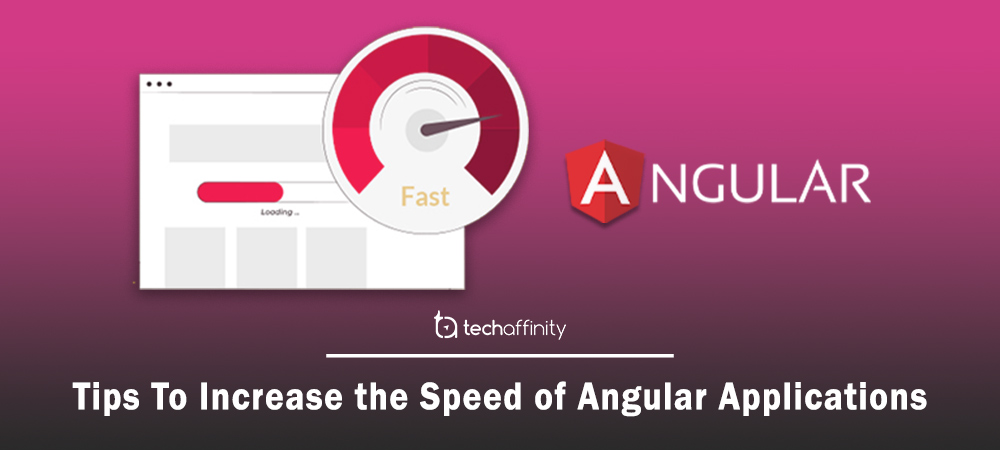Tips to Increase the Speed of Angular Applications

Author : TechAffinity 11th Jan 2022

Websites are being designed more efficiently to attract the attention of customers by introducing remarkable features as a result of significant technological advancements. Users appear to be irritated by the lengthy time it takes for the website to load. One thing we should be clear about is that waiting will also result in the loss of potential clients. So, how can we improve the website’s speed in order to keep customers?
Angular is a powerful and high-performing front-end framework by default. Unexpected issues are certain to arise while developing mission-critical web apps, especially those that are content-heavy and architecturally complicated. Performance issues show up in ways that have a direct impact on the end-user experience. However, a drop in traffic or the absence of traffic, a fall in engagement, and a high bounce rate are some of the indicators that your application is experiencing performance issues. In situations like this, our goal should be to identify the problem before attempting to solve it. However, before we get started with Angular speed optimization, let’s have a look at some typical performance bottlenecks and how to fix them.
The following are some of the most common issues that applications face:
- Unnecessary server usage
- Slow page response
- Unexpected app crash
- Periodic slowdown
- Not meeting expected results with the migrated technology
- Unexpected errors due to a real-time data stream
These issues can almost probably be solved with Angular optimization approaches. We’ll show you how to make your Angular app smaller, faster, and more responsive in this article. Let’s get started.
1. Lazy Loading module
The perfect plot for releasing the complexity of routers and components is lazy loading. It allows you to separate a large chunk file into many files and load JavaScript components only when the relevant router is triggered, avoiding the hassle of dealing with Chunk files.
2. Ahead-of-Time Compilation (AOT)
This compiler will turn your typescript code into polished JavaScript code before running it, optimizing and compressing the entire structure of the code. Start focusing on page speed once the angular application has completed these in-built optimization features.
AOT anticipates compilation at build time, creates just the compiled templates, and removes the Angular compiler from the deployment bundle, resulting in a 1MB reduction in the app payload (roughly the size of the Angular compiler). To take advantage of AOT, you can compile using CLI commands with the – AOT switch.
3. Minification
Many characters in our JavaScript code are used solely for readability and visual purposes, such as white spaces, newline characters, comments, and block delimiters. They aren’t required for the code to function properly. These characters are removed, names are simplified, and unreachable code is ignored during the minification process. You can reduce page download and execution times by minifying your code.
4. Build Optimizer
Build an Optimizer is a tool developed by the Angular team to improve Angular Webpack builds. It finds code that can be eliminated without causing problems during the construction process. Build Optimizer, for example, can remove Angular decorators such as Component from AOT builds. These decorators are only required at compile time because the compiler gets all relevant information from them.
5. Code Splitting
Code splitting is one method of reducing initial load time and speeding up page navigation. The size of the JavaScript files sent to users expanded as web applications became more complex. Large JavaScript files can slow down browser interactions, especially for mobile users.
With no loss of functionality, code splitting efficiently minimizes JavaScript bundles in your project. This method allows you to split the JavaScript code into numerous portions that can be loaded in stages as the user navigates via different routes or opens or expands components.
Component-level code-splitting, in which individual components can be loaded lazily even without route navigation, and route-level code-splitting, in which individual routes are loaded lazily, are the two basic ways.
6. OnPush Change Detection
Angular will inspect every component by default to see if it has changed and updated the view accordingly. While this is a quick operation, as your program expands, these frequent update checks become more time-consuming.
OnPush change detection reacts solely to changes in the @input parameters, or when you actively initiate detection, unlike the default technique, which checks a component whenever there is a change in your app.
7. Pipes Instead of methods
The Angular pipes approach is the greatest option for change detection. Pure pipes and impure pipes are the two sorts. Pure pipelines eliminate the need to recalculate values and complicated numbers, and they distill the intended results even more. When the input differs from the prior invocations, it merely returns values. As a result, you can reduce the use of functions and methods in the template by replacing them with pipes, because a pipe is only executed when input values change, whereas a function or method is called on every change detection. As we’ve seen, the optimization strategies mentioned here address a variety of issues with a variety of solutions, and not all of the suggestions will have the same influence on your application’s performance.
This list of Angular optimization recommendations will almost certainly result in benefits to fine-tune your project; utilizing these features will help your Angular app be smaller, faster, and more responsive. The future holds a fine line between clean code and performance that will satisfy both your end-users and you. Please contact us if you require assistance in adopting these techniques, clarifications, or if something is incorrect.
Conclusion
If you want your application to perform better and faster, and its features to be easy to implement. Our expert developers can help you migrate your existing applications, create new web and mobile applications with the best quality and premium rates. You can shoot your queries to media@techaffinity.com and our team will get in touch with you.